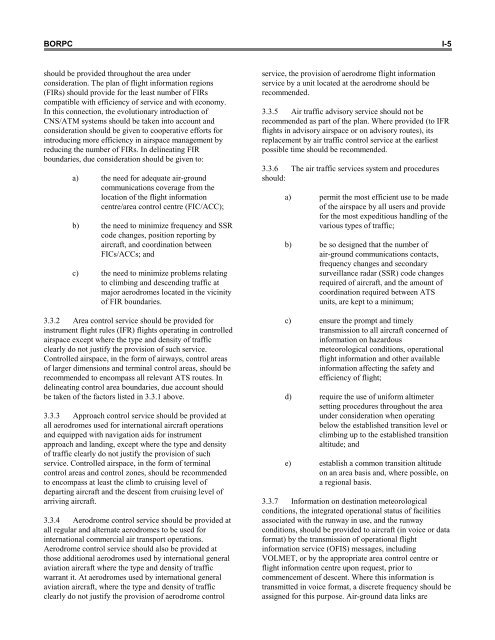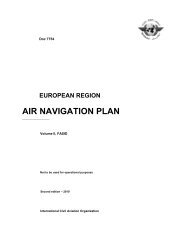7754 Vol 1 Flyleaf - ICAO Public Maps
7754 Vol 1 Flyleaf - ICAO Public Maps
7754 Vol 1 Flyleaf - ICAO Public Maps
You also want an ePaper? Increase the reach of your titles
YUMPU automatically turns print PDFs into web optimized ePapers that Google loves.
BORPC I-5<br />
should be provided throughout the area under<br />
consideration. The plan of flight information regions<br />
(FIRs) should provide for the least number of FIRs<br />
compatible with efficiency of service and with economy.<br />
In this connection, the evolutionary introduction of<br />
CNS/ATM systems should be taken into account and<br />
consideration should be given to cooperative efforts for<br />
introducing more efficiency in airspace management by<br />
reducing the number of FIRs. In delineating FIR<br />
boundaries, due consideration should be given to:<br />
a) the need for adequate air-ground<br />
communications coverage from the<br />
location of the flight information<br />
centre/area control centre (FIC/ACC);<br />
b) the need to minimize frequency and SSR<br />
code changes, position reporting by<br />
aircraft, and coordination between<br />
FICs/ACCs; and<br />
c) the need to minimize problems relating<br />
to climbing and descending traffic at<br />
major aerodromes located in the vicinity<br />
of FIR boundaries.<br />
3.3.2 Area control service should be provided for<br />
instrument flight rules (IFR) flights operating in controlled<br />
airspace except where the type and density of traffic<br />
clearly do not justify the provision of such service.<br />
Controlled airspace, in the form of airways, control areas<br />
of larger dimensions and terminal control areas, should be<br />
recommended to encompass all relevant ATS routes. In<br />
delineating control area boundaries, due account should<br />
be taken of the factors listed in 3.3.1 above.<br />
3.3.3 Approach control service should be provided at<br />
all aerodromes used for international aircraft operations<br />
and equipped with navigation aids for instrument<br />
approach and landing, except where the type and density<br />
of traffic clearly do not justify the provision of such<br />
service. Controlled airspace, in the form of terminal<br />
control areas and control zones, should be recommended<br />
to encompass at least the climb to cruising level of<br />
departing aircraft and the descent from cruising level of<br />
arriving aircraft.<br />
3.3.4 Aerodrome control service should be provided at<br />
all regular and alternate aerodromes to be used for<br />
international commercial air transport operations.<br />
Aerodrome control service should also be provided at<br />
those additional aerodromes used by international general<br />
aviation aircraft where the type and density of traffic<br />
warrant it. At aerodromes used by international general<br />
aviation aircraft, where the type and density of traffic<br />
clearly do not justify the provision of aerodrome control<br />
service, the provision of aerodrome flight information<br />
service by a unit located at the aerodrome should be<br />
recommended.<br />
3.3.5 Air traffic advisory service should not be<br />
recommended as part of the plan. Where provided (to IFR<br />
flights in advisory airspace or on advisory routes), its<br />
replacement by air traffic control service at the earliest<br />
possible time should be recommended.<br />
3.3.6 The air traffic services system and procedures<br />
should:<br />
a) permit the most efficient use to be made<br />
of the airspace by all users and provide<br />
for the most expeditious handling of the<br />
various types of traffic;<br />
b) be so designed that the number of<br />
air-ground communications contacts,<br />
frequency changes and secondary<br />
surveillance radar (SSR) code changes<br />
required of aircraft, and the amount of<br />
coordination required between ATS<br />
units, are kept to a minimum;<br />
c) ensure the prompt and timely<br />
transmission to all aircraft concerned of<br />
information on hazardous<br />
meteorological conditions, operational<br />
flight information and other available<br />
information affecting the safety and<br />
efficiency of flight;<br />
d) require the use of uniform altimeter<br />
setting procedures throughout the area<br />
under consideration when operating<br />
below the established transition level or<br />
climbing up to the established transition<br />
altitude; and<br />
e) establish a common transition altitude<br />
on an area basis and, where possible, on<br />
a regional basis.<br />
3.3.7 Information on destination meteorological<br />
conditions, the integrated operational status of facilities<br />
associated with the runway in use, and the runway<br />
conditions, should be provided to aircraft (in voice or data<br />
format) by the transmission of operational flight<br />
information service (OFIS) messages, including<br />
VOLMET, or by the appropriate area control centre or<br />
flight information centre upon request, prior to<br />
commencement of descent. Where this information is<br />
transmitted in voice format, a discrete frequency should be<br />
assigned for this purpose. Air-ground data links are














